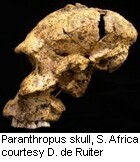
WEDNESDAY, Oct. 3 (HealthDay News) — A 1.5-million-year-old skull fragment suggests that early humans ate meat with some regularity, according to a new report.
The fragment of a young child’s skull found at Olduvai Gorge in Tanzania has bone lesions that offer the earliest known evidence of anemia caused by a lack of vitamin B in the diet.
The lesions on the skull of the child, who was somewhat younger than 2 years old at the time of death, suggest that meat consumption among early humans was common enough that not eating it could lead to anemia, explained study leader Manuel Dominguez-Rodrigo, from Complutense University in Madrid, Spain, and colleagues.
Anemia and other nutritional deficiencies are most common at weaning, when there is a major change in children’s diets. The skull fragment may come from a child who died at the time when he or she was starting to eat solid foods but was lacking meat. Or it could be that the child still depended on the mother’s milk and the mother may have been nutritionally deficient due to a lack of meat, the researchers explained in the report published Oct. 3 in the online journal PLoS One.
Both possibilities suggest that “early humans were hunters, and had a physiology adapted to regular meat consumption at least 1.5 million years ago,” the researchers concluded in a journal news release.
The study follows previous research that showed early humans ate meat, but it wasn’t clear if meat was a regular or occasional part of their diet.
More information
The American Heart Association offers advice about eating meat, fish and poultry.

